Haomin Wen
Embracing Large Language Models in Traffic Flow Forecasting
Dec 15, 2024Abstract:Traffic flow forecasting aims to predict future traffic flows based on the historical traffic conditions and the road network. It is an important problem in intelligent transportation systems, with a plethora of methods been proposed. Existing efforts mainly focus on capturing and utilizing spatio-temporal dependencies to predict future traffic flows. Though promising, they fall short in adapting to test-time environmental changes of traffic conditions. To tackle this challenge, we propose to introduce large language models (LLMs) to help traffic flow forecasting and design a novel method named Large Language Model Enhanced Traffic Flow Predictor (LEAF). LEAF adopts two branches, capturing different spatio-temporal relations using graph and hypergraph structures respectively. The two branches are first pre-trained individually, and during test-time, they yield different predictions. Based on these predictions, a large language model is used to select the most likely result. Then, a ranking loss is applied as the learning objective to enhance the prediction ability of the two branches. Extensive experiments on several datasets demonstrate the effectiveness of the proposed LEAF.
DRL4AOI: A DRL Framework for Semantic-aware AOI Segmentation in Location-Based Services
Dec 06, 2024



Abstract:In Location-Based Services (LBS), such as food delivery, a fundamental task is segmenting Areas of Interest (AOIs), aiming at partitioning the urban geographical spaces into non-overlapping regions. Traditional AOI segmentation algorithms primarily rely on road networks to partition urban areas. While promising in modeling the geo-semantics, road network-based models overlooked the service-semantic goals (e.g., workload equality) in LBS service. In this paper, we point out that the AOI segmentation problem can be naturally formulated as a Markov Decision Process (MDP), which gradually chooses a nearby AOI for each grid in the current AOI's border. Based on the MDP, we present the first attempt to generalize Deep Reinforcement Learning (DRL) for AOI segmentation, leading to a novel DRL-based framework called DRL4AOI. The DRL4AOI framework introduces different service-semantic goals in a flexible way by treating them as rewards that guide the AOI generation. To evaluate the effectiveness of DRL4AOI, we develop and release an AOI segmentation system. We also present a representative implementation of DRL4AOI - TrajRL4AOI - for AOI segmentation in the logistics service. It introduces a Double Deep Q-learning Network (DDQN) to gradually optimize the AOI generation for two specific semantic goals: i) trajectory modularity, i.e., maximize tightness of the trajectory connections within an AOI and the sparsity of connections between AOIs, ii) matchness with the road network, i.e., maximizing the matchness between AOIs and the road network. Quantitative and qualitative experiments conducted on synthetic and real-world data demonstrate the effectiveness and superiority of our method. The code and system is publicly available at https://github.com/Kogler7/AoiOpt.
Uncertainty-aware Human Mobility Modeling and Anomaly Detection
Oct 02, 2024Abstract:Given the GPS coordinates of a large collection of human agents over time, how can we model their mobility behavior toward effective anomaly detection (e.g. for bad-actor or malicious behavior detection) without any labeled data? Human mobility and trajectory modeling have been studied extensively with varying capacity to handle complex input, and performance-efficiency trade-offs. With the arrival of more expressive models in machine learning, we attempt to model GPS data as a sequence of stay-point events, each with a set of characterizing spatiotemporal features, and leverage modern sequence models such as Transformers for un/self-supervised training and inference. Notably, driven by the inherent stochasticity of certain individuals' behavior, we equip our model with aleatoric/data uncertainty estimation. In addition, to handle data sparsity of a large variety of behaviors, we incorporate epistemic/model uncertainty into our model. Together, aleatoric and epistemic uncertainty enable a robust loss and training dynamics, as well as uncertainty-aware decision making in anomaly scoring. Experiments on large expert-simulated datasets with tens of thousands of agents demonstrate the effectiveness of our model against both forecasting and anomaly detection baselines.
Zero-shot Outlier Detection via Prior-data Fitted Networks: Model Selection Bygone!
Sep 09, 2024Abstract:Outlier detection (OD) has a vast literature as it finds numerous applications in environmental monitoring, cybersecurity, finance, and medicine to name a few. Being an inherently unsupervised task, model selection is a key bottleneck for OD (both algorithm and hyperparameter selection) without label supervision. There is a long list of techniques to choose from -- both classical algorithms and deep neural architectures -- and while several studies report their hyperparameter sensitivity, the literature is quite slim on unsupervised model selection -- limiting the effective use of OD in practice. In this paper we present FoMo-0D, for zero/0-shot OD exploring a transformative new direction that bypasses the hurdle of model selection altogether (!), thus breaking new ground. The fundamental idea behind FoMo-0D is the Prior-data Fitted Networks, recently introduced by Muller et al.(2022), which trains a Transformer model on a large body of synthetically generated data from a prior data distribution. In essence, FoMo-0D is a pretrained Foundation Model for zero/0-shot OD on tabular data, which can directly predict the (outlier/inlier) label of any test data at inference time, by merely a single forward pass -- making obsolete the need for choosing an algorithm/architecture, tuning its associated hyperparameters, and even training any model parameters when given a new OD dataset. Extensive experiments on 57 public benchmark datasets against 26 baseline methods show that FoMo-0D performs statistically no different from the top 2nd baseline, while significantly outperforming the majority of the baselines, with an average inference time of 7.7 ms per test sample.
DutyTTE: Deciphering Uncertainty in Origin-Destination Travel Time Estimation
Aug 23, 2024Abstract:Uncertainty quantification in travel time estimation (TTE) aims to estimate the confidence interval for travel time, given the origin (O), destination (D), and departure time (T). Accurately quantifying this uncertainty requires generating the most likely path and assessing travel time uncertainty along the path. This involves two main challenges: 1) Predicting a path that aligns with the ground truth, and 2) modeling the impact of travel time in each segment on overall uncertainty under varying conditions. We propose DutyTTE to address these challenges. For the first challenge, we introduce a deep reinforcement learning method to improve alignment between the predicted path and the ground truth, providing more accurate travel time information from road segments to improve TTE. For the second challenge, we propose a mixture of experts guided uncertainty quantification mechanism to better capture travel time uncertainty for each segment under varying contexts. Additionally, we calibrate our results using Hoeffding's upper-confidence bound to provide statistical guarantees for the estimated confidence intervals. Extensive experiments on two real-world datasets demonstrate the superiority of our proposed method.
PTrajM: Efficient and Semantic-rich Trajectory Learning with Pretrained Trajectory-Mamba
Aug 09, 2024



Abstract:Vehicle trajectories provide crucial movement information for various real-world applications. To better utilize vehicle trajectories, it is essential to develop a trajectory learning approach that can effectively and efficiently extract rich semantic information, including movement behavior and travel purposes, to support accurate downstream applications. However, creating such an approach presents two significant challenges. First, movement behavior are inherently spatio-temporally continuous, making them difficult to extract efficiently from irregular and discrete trajectory points. Second, travel purposes are related to the functionalities of areas and road segments traversed by vehicles. These functionalities are not available from the raw spatio-temporal trajectory features and are hard to extract directly from complex textual features associated with these areas and road segments. To address these challenges, we propose PTrajM, a novel method capable of efficient and semantic-rich vehicle trajectory learning. To support efficient modeling of movement behavior, we introduce Trajectory-Mamba as the learnable model of PTrajM, which effectively extracts continuous movement behavior while being more computationally efficient than existing structures. To facilitate efficient extraction of travel purposes, we propose a travel purpose-aware pre-training procedure, which enables PTrajM to discern the travel purposes of trajectories without additional computational resources during its embedding process. Extensive experiments on two real-world datasets and comparisons with several state-of-the-art trajectory learning methods demonstrate the effectiveness of PTrajM. Code is available at https://anonymous.4open.science/r/PTrajM-C973.
UniTE: A Survey and Unified Pipeline for Pre-training ST Trajectory Embeddings
Jul 17, 2024



Abstract:Spatio-temporal (ST) trajectories are sequences of timestamped locations, which enable a variety of analyses that in turn enable important real-world applications. It is common to map trajectories to vectors, called embeddings, before subsequent analyses. Thus, the qualities of embeddings are very important. Methods for pre-training embeddings, which leverage unlabeled trajectories for training universal embeddings, have shown promising applicability across different tasks, thus attracting considerable interest. However, research progress on this topic faces two key challenges: a lack of a comprehensive overview of existing methods, resulting in several related methods not being well-recognized, and the absence of a unified pipeline, complicating the development new methods and the analysis of methods. To overcome these obstacles and advance the field of pre-training of trajectory embeddings, we present UniTE, a survey and a unified pipeline for this domain. In doing so, we present a comprehensive list of existing methods for pre-training trajectory embeddings, which includes methods that either explicitly or implicitly employ pre-training techniques. Further, we present a unified and modular pipeline with publicly available underlying code, simplifying the process of constructing and evaluating methods for pre-training trajectory embeddings. Additionally, we contribute a selection of experimental results using the proposed pipeline on real-world datasets.
Learning Geospatial Region Embedding with Heterogeneous Graph
May 23, 2024Abstract:Learning effective geospatial embeddings is crucial for a series of geospatial applications such as city analytics and earth monitoring. However, learning comprehensive region representations presents two significant challenges: first, the deficiency of effective intra-region feature representation; and second, the difficulty of learning from intricate inter-region dependencies. In this paper, we present GeoHG, an effective heterogeneous graph structure for learning comprehensive region embeddings for various downstream tasks. Specifically, we tailor satellite image representation learning through geo-entity segmentation and point-of-interest (POI) integration for expressive intra-regional features. Furthermore, GeoHG unifies informative spatial interdependencies and socio-environmental attributes into a powerful heterogeneous graph to encourage explicit modeling of higher-order inter-regional relationships. The intra-regional features and inter-regional correlations are seamlessly integrated by a model-agnostic graph learning framework for diverse downstream tasks. Extensive experiments demonstrate the effectiveness of GeoHG in geo-prediction tasks compared to existing methods, even under extreme data scarcity (with just 5% of training data). With interpretable region representations, GeoHG exhibits strong generalization capabilities across regions. We will release code and data upon paper notification.
PLM4Traj: Cognizing Movement Patterns and Travel Purposes from Trajectories with Pre-trained Language Models
May 21, 2024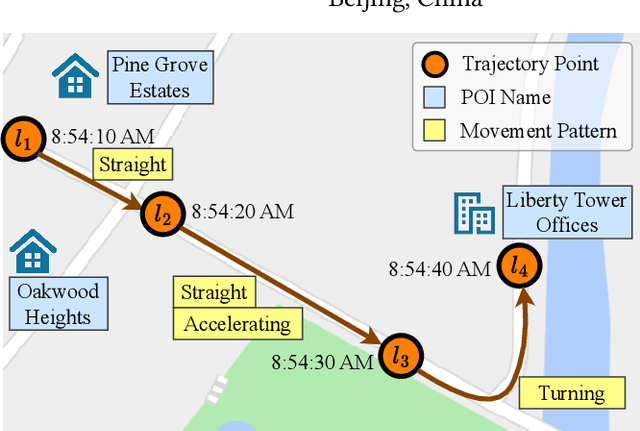
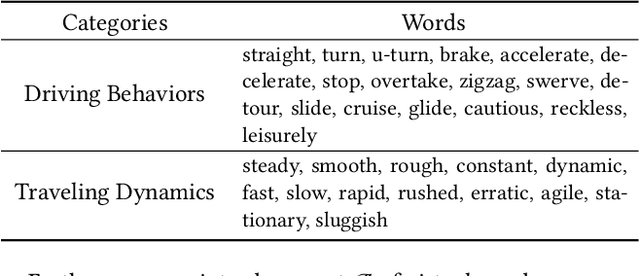
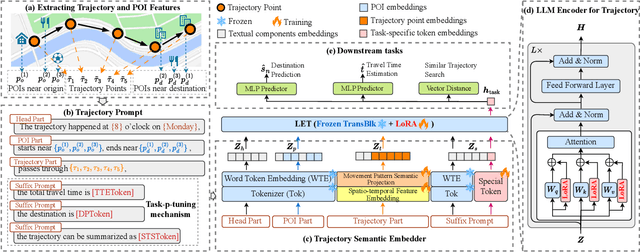

Abstract:Spatio-temporal trajectories play a vital role in various spatio-temporal data mining tasks. Developing a versatile trajectory learning approach that can adapt to different tasks while ensuring high accuracy is crucial. This requires effectively extracting movement patterns and travel purposes embedded in trajectories. However, this task is challenging due to limitations in the size and quality of available trajectory datasets. On the other hand, pre-trained language models (PLMs) have shown great success in adapting to different tasks by training on large-scale, high-quality corpus datasets. Given the similarities between trajectories and sentences, there is potential in leveraging PLMs to enhance the development of a versatile and effective trajectory learning method. Nevertheless, vanilla PLMs are not tailored to handle the unique spatio-temporal features present in trajectories and lack the capability to extract movement patterns and travel purposes from them. To overcome these obstacles, we propose a model called PLM4Traj that effectively utilizes PLMs to model trajectories. PLM4Traj leverages the strengths of PLMs to create a versatile trajectory learning approach while addressing the limitations of vanilla PLMs in modeling trajectories. Firstly, PLM4Traj incorporates a novel trajectory semantic embedder that enables PLMs to process spatio-temporal features in trajectories and extract movement patterns and travel purposes from them. Secondly, PLM4Traj introduces a novel trajectory prompt that integrates movement patterns and travel purposes into PLMs, while also allowing the model to adapt to various tasks. Extensive experiments conducted on two real-world datasets and two representative tasks demonstrate that PLM4Traj successfully achieves its design goals. Codes are available at https://github.com/Zeru19/PLM4Traj.
A Survey on Diffusion Models for Time Series and Spatio-Temporal Data
Apr 29, 2024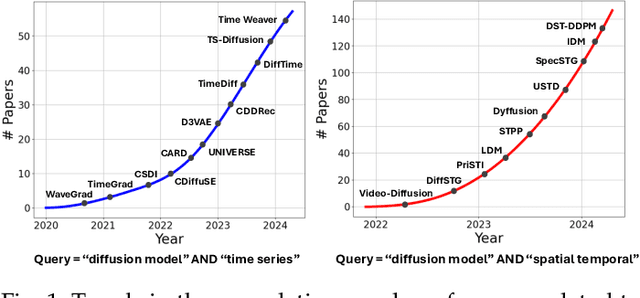
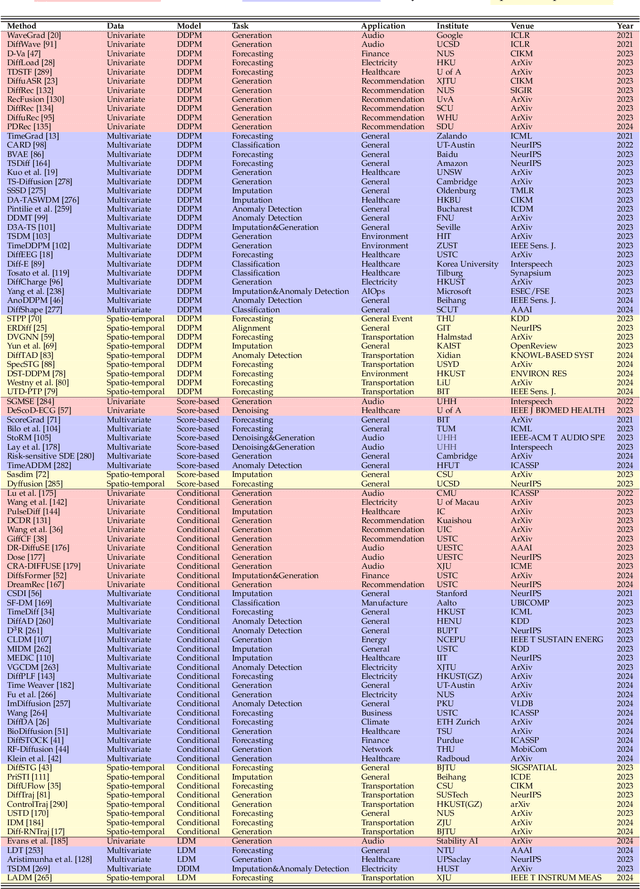
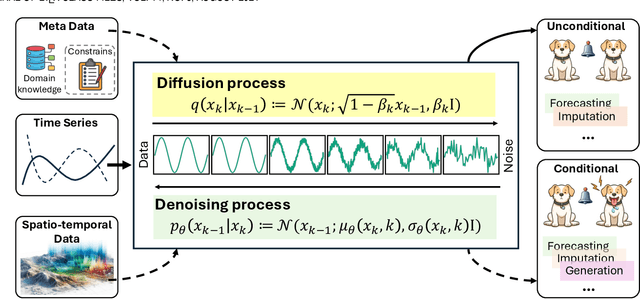
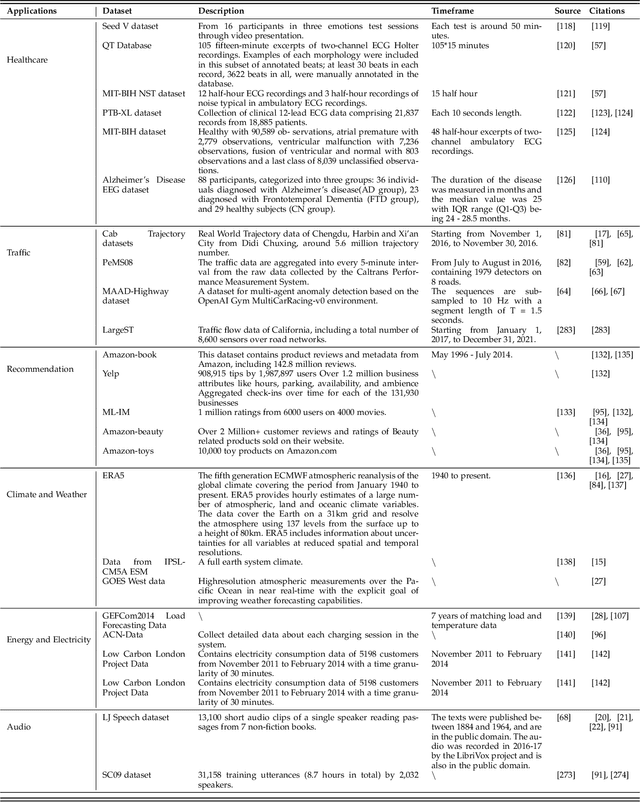
Abstract:The study of time series data is crucial for understanding trends and anomalies over time, enabling predictive insights across various sectors. Spatio-temporal data, on the other hand, is vital for analyzing phenomena in both space and time, providing a dynamic perspective on complex system interactions. Recently, diffusion models have seen widespread application in time series and spatio-temporal data mining. Not only do they enhance the generative and inferential capabilities for sequential and temporal data, but they also extend to other downstream tasks. In this survey, we comprehensively and thoroughly review the use of diffusion models in time series and spatio-temporal data, categorizing them by model category, task type, data modality, and practical application domain. In detail, we categorize diffusion models into unconditioned and conditioned types and discuss time series data and spatio-temporal data separately. Unconditioned models, which operate unsupervised, are subdivided into probability-based and score-based models, serving predictive and generative tasks such as forecasting, anomaly detection, classification, and imputation. Conditioned models, on the other hand, utilize extra information to enhance performance and are similarly divided for both predictive and generative tasks. Our survey extensively covers their application in various fields, including healthcare, recommendation, climate, energy, audio, and transportation, providing a foundational understanding of how these models analyze and generate data. Through this structured overview, we aim to provide researchers and practitioners with a comprehensive understanding of diffusion models for time series and spatio-temporal data analysis, aiming to direct future innovations and applications by addressing traditional challenges and exploring innovative solutions within the diffusion model framework.
 Add to Chrome
Add to Chrome Add to Firefox
Add to Firefox Add to Edge
Add to Edge